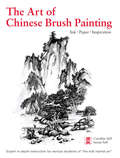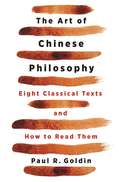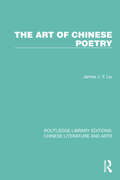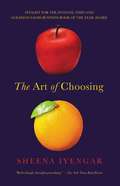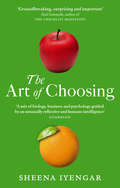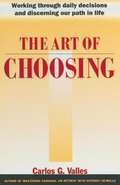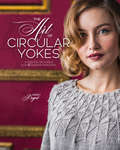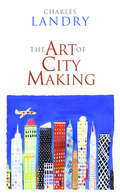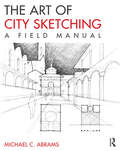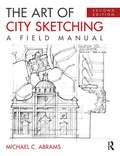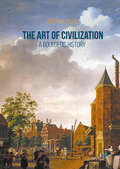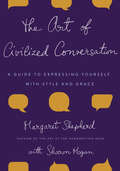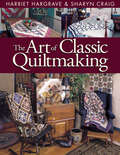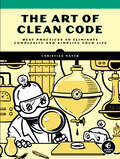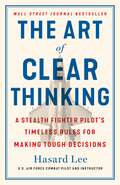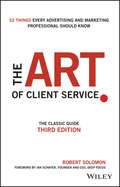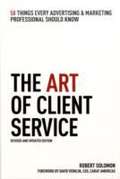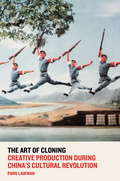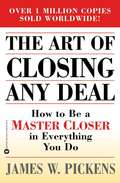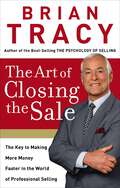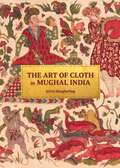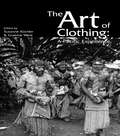- Table View
- List View
The Art of Chinese Brush Painting
by Susan Self Caroline SelfChinese ink painting is an offshoot of calligraphy and is a beautiful and reflective art that's been revered in China for centuries. A wonderfully creative tool, this book is an excellent way for newcomers to experience this ancient art form.Traditional black-and-white Chinese ink painting elements, along with the tradition's essentials--such as the quality and variety of the tools and accessories used in its practice are all covered. The Art of Chinese Brush Painting encourages readers to be mindful of the principles of composition and perspective, and introduces specific techniques for several different elements, including Chinese Zodiac animals and landscapes.
The Art of Chinese Brush Painting
by Susan Self Caroline SelfChinese ink painting is an offshoot of calligraphy and is a beautiful and reflective art that's been revered in China for centuries. A wonderfully creative tool, this book is an excellent way for newcomers to experience this ancient art form.Traditional black-and-white Chinese ink painting elements, along with the tradition's essentials--such as the quality and variety of the tools and accessories used in its practice are all covered. The Art of Chinese Brush Painting encourages readers to be mindful of the principles of composition and perspective, and introduces specific techniques for several different elements, including Chinese Zodiac animals and landscapes.
The Art of Chinese Philosophy: Eight Classical Texts and How to Read Them
by Paul GoldinA smart and accessible introduction to the most important works of ancient Chinese philosophy—the Analects of Confucius, Mozi, Mencius, Laozi, Zhuangzi, Sunzi, Xunzi, and Han FeiziThis book provides an unmatched introduction to eight of the most important works of classical Chinese philosophy—the Analects of Confucius, Mozi, Mencius, Laozi, Zhuangzi, Sunzi, Xunzi, and Han Feizi. Combining accessibility with the latest scholarship, Paul Goldin, one of the world's leading authorities on the history of Chinese philosophy, places these works in rich context as he explains the origin and meaning of their compelling ideas.Because none of these classics was written in its current form by the author to whom it is attributed, the book begins by asking, "What are we reading?" and showing that understanding the textual history of the works enriches our appreciation of them. A chapter is devoted to each of the eight works, and the chapters are organized into three sections: "Philosophy of Heaven," which looks at how the Analects, Mozi, and Mencius discuss, often skeptically, Heaven (tian) as a source of philosophical values; "Philosophy of the Way," which addresses how Laozi, Zhuangzi, and Sunzi introduce the new concept of the Way (dao) to transcend the older paradigms; and "Two Titans at the End of an Age," which examines how Xunzi and Han Feizi adapt the best ideas of the earlier thinkers for a coming imperial age.In addition, the book presents clear and insightful explanations of the protean and frequently misunderstood concept of qi—and of a crucial characteristic of Chinese philosophy, nondeductive reasoning. The result is an invaluable account of an endlessly fascinating and influential philosophical tradition.
The Art of Chinese Poetry (Routledge Library Editions: Chinese Literature and Arts #1)
by James J.Y. LiuThis book, first published in 1962, is a majestic survey of the whole structure of Chinese poetry. It is a critical introduction to the field as well as an exposition of Chinese views on the nature of poetry. It discusses the Chinese language as a poetic medium from various angles – visual, semantic, auditory, grammatical and conceptual. It also describes the bases of Chinese versification and the major verse forms, and offers interpretations of various schools of traditional Chinese criticisms of poetry. The author suggests a synthesis among the different schools and evolves a view of poetry from which critical standards for Chinese poetry can be derived. In applying these standards, he attempts a further synthesis – one between this mainly traditional Chinese view of poetry and the modern Western method of verbal analysis. Imagery, symbolism, allusions and other features of Chinese poetry are analysed critically.
The Art of Choosing
by Sheena IyengarEvery day we make choices. Coke or Pepsi? Save or spend? Stay or go? Whether mundane or life-altering, these choices define us and shape our lives. Sheena Iyengar asks the difficult questions about how and why we choose: Is the desire for choice innate or bound by culture? Why do we sometimes choose against our best interests? How much control do we really have over what we choose? Sheena Iyengar's award-winning research reveals that the answers are surprising and profound. In our world of shifting political and cultural forces, technological revolution, and interconnected commerce, our decisions have far-reaching consequences. Use THE ART OF CHOOSING as your companion and guide for the many challenges ahead.
The Art Of Choosing: The Decisions We Make Everyday of our Lives, What They Say About Us and How We Can Improve Them
by Sheena IyengarEvery day we make choices. Coke or Pepsi? Save or spend? Stay or go?Whether mundane or life-altering, these choices define us and shape our lives. Sheena Iyengar asks the difficult questions about how and why we choose: Is the desire for choice innate or bound by culture? Why do we sometimes choose against our best interests? How much control do we really have over what we choose? Her award-winning research reveals that the answers are surprising and profound. In our world of shifting political and cultural forces, technological revolution, and interconnected commerce, our decisions have far-reaching consequences. Use this book as your companion and guide for the many challenges ahead.'No one asks better questions, or comes up with more intriguing answers' Malcolm Gladwell, author of THE TIPPING POINT
The Art of Choosing
by Carlos G. VallesUsing insights from scripture, Ignatian spirituality, and contemporary examples, Valles illustrates the basics of making choices with care and forethought.
The Art of Cidermaking
by Paul CorrentyThis book is not just about how to make the cider, it is about how to enjoy making the cider. What equipment does the beginner need? Which apples are best? Which apples are affordable? What is the history of fermenting apple juice? A fine book for the cider enthusiast and the armchair cook.
The Art of Circular Yokes: A Timeless Technique for 15 Modern Sweaters
by Kerry BogertKnit a masterpiece! Discover the how yarn and needles become artistic tools when you work on the beautiful canvas of a circular yoke. The timeless technique of knitting sweaters with nearly invisible shaping allows for painterly colorwork, illustrative lace, beautifully chiseled cables, and so much more. Open the pages of The Art of Circular Yokes to find: • Detailed information on the math behind circular yokes and how to achieve a more customized fit from designer Holli Yeoh. Plus insights into designing your own original patterns. • Curated collection of 15 stunning circular yoke pullovers and cardigans from some of your favorite designers--including Jenn Steingass, Kate Gagnon Osborn, Jennifer Wood, Andrea Cull, and others. • Projects that once knit become treasured keepsakes for years to come.No handknit wardrobe is completely with one of these iconic sweaters. With The Art of Circular Yokes you have everything you need to make an heirloom for your collection.
The Art of City-Making
by Charles LandryCity-making is an art, not a formula. The skills required to re-enchant the city are far wider than the conventional ones like architecture, engineering and land-use planning. There is no simplistic, ten-point plan, but strong principles can help send good city-making on its way. The vision for 21st century cities must be to be the most imaginative cities for the world rather than in the world. This one change of word - from 'in' to 'for' - gives city-making an ethical foundation and value base. It helps cities become places of solidarity where the relations between the individual, the group, outsiders to the city and the planet are in better alignment. Following the widespread success of The Creative City, this new book, aided by international case studies, explains how to reassess urban potential so that cities can strengthen their identity and adapt to the changing global terms of trade and mass migration. It explores the deeper fault-lines, paradoxes and strategic dilemmas that make creating the 'good city' so difficult.
The Art of City Sketching: A Field Manual
by Michael AbramsThe Art of City Sketching: A Field Manual guides you through the laborious and sometimes complex process of sketching what you see in the built environment so that you can learn to draw what you imagine. Illustrated with hundreds of drawings by students and professionals of cityscapes around Europe and the United States, the book helps you develop your conceptual drawing skills so that you can communicate graphically to represent the built environment. Short exercises, projects, drawing tips, step-by-step demonstrations, and composition do's and don'ts make it easy for you to get out into the city and experiment in your own work. Author Michael Abrams uses his experience as a field sketching instructor, to show you that by drawing, you can discover, analyze, and comprehend the built environment.
The Art of City Sketching: A Field Manual
by Michael C. AbramsThe Art of City Sketching: A Field Manual guides readers through the process of freehand architectural sketching and explains orthographic, diagrammatic, three-dimensional, and perceptual-type drawings. The book presents hundreds of drawings of historic buildings and urban spaces, examples, and exercises, which help readers develop their drawing skills and employ sketching as an analytical tool. The book is divided into three parts, based on the reader’s skill level: beginner, intermediate, and advanced. As an architect and field sketching instructor, the author shows that through drawing the reader can discover, analyze, and comprehend the built environment. The new edition of The Art of City Sketching expands on the drawing techniques of the previous version by adding new drawing examples, exercises, and two new chapters—Chiaroscuro and Storyboard. New drawing tips, demonstrations, and composition "do’s and don’ts" will support readers when they illustrate their viewpoint of the city by using simple drawing tools. The lessons in this book will allow readers to mix method with imagination and sensibility.
The Art of Civilization
by Didier MaleuvreDidier Maleuvre argues that works of art in Western societies from Ancient Greece to the interconnected worlds of the Digital Age have served to rationalize and normalize an engagement with bourgeois civilization and the city. Maleuvre details that the history of art itself is the history civilization, giving rise to the particular aesthetics and critical attitudes of respective moments and movements in changing civilizations in a dialogical mode. Building a visual cultural account of shifting forms of culture, power, and subjectivity, Maleuvre illustrates how art gave a pattern and a language to the model of social authority rather than simply functioning as a reflective one. Through a broad cultural study of the relationship between humanity, art, and the culture of civilization, Maleuvre introduces a new set of paradigms that critique and affirm the relationship between humanity and art, arguing for it as an engine of social reproduction that transforms how culture is inhabited.
The Art of Civilized Conversation: A Guide to Expressing Yourself With Style and Grace
by Margaret Shepherd Sharon HoganIn our fast-paced, electronic society, the most basic social interaction—talking face-to-face—can be a challenge for even the most educated and self-assured individuals. And yet making conversation is a highly practical skill: those who do it well shine at networking parties, interviews, and business lunches. Good conversation also opens doors to a happier love life, warmer friendships, and more rewarding time with family. For those intimidated by the complexity of personal interaction, or those simply looking to polish their speaking skills,The Art of Civilized Conversationis a powerful guide to communicating in an endearing way. In its pages, author Margaret Shepherd offers opening lines, graceful apologies, thoughtful questions, and, ultimately, the confidence to take conversations beyondhello. From the basics—first impressions, appropriate subject matter, and graceful exits—to finding the right words for difficult situations and an insightful discussion of body language, Shepherd uses her skilled eye and humorous anecdotes to teach readers how to turn a plain conversation into an engaging encounter. Filled with common sense and fresh insight,The Art of Civilized Conversationis the perfect inspiration not only for what to say but for how to say it with style.
The Art of Classic Quiltmaking: The Ultimate How-to Book For Quilters!
by Harriet Hargrave Sharyn CraigThe ultimate how-to book for quilters—a workbook with exercises that provide a foundation of much-needed basics to set you on your quilting path. Two of quilting&’s most respected teachers combine their different styles to present an incredible reference and project book that beginners and experienced quilters alike will always keep near the sewing machine! Loaded with the information you need to make traditional quilts, including selecting and caring for fabric, choosing equipment and supplies, calculating yardage, selecting the piecing technique that ensures the best result, designing borders, and deciding on quilting designs. Designed for those who encounter problems with quilting basics, from confident beginners to experienced quilters. Master piecing methods with step-by-step exercises, helpful hints, illustrations, and photos. Project quilts accompany each basic technique chapter. Numerous variations of the techniques are also presented. Find out how to answer questions such as &“where do I go next?&” or &“what went wrong?&”
The Art of Clean Code: Best Practices to Eliminate Complexity and Simplify Your Life
by Christian MayerLearn eight principles to simplify your code and become a more effective (and successful) programmer.Most software developers waste thousands of hours working with overly complex code. The eight core principles in The Art of Clean Coding will teach you how to write clear, maintainable code without compromising functionality. The book&’s guiding principle is simplicity: reduce and simplify, then reinvest energy in the important parts to save you countless hours and ease the often onerous task of code maintenance.Bestselling author Christian Mayer leverages his experience helping thousands perfect their coding skills in this new book. With expert advice and real-world examples, he&’ll show you how to: Concentrate on the important stuff with the 80/20 principle -- focus on the 20% of your code that matters mostAvoid coding in isolation: create a minimum viable product to get early feedbackWrite code cleanly and simply to eliminate clutter Avoid premature optimization that risks over-complicating code Balance your goals, capacity, and feedback to achieve the productive state of FlowApply the Do One Thing Well philosophy to vastly improve functionalityDesign efficient user interfaces with the Less is More principleTie your new skills together into one unifying principle: Focus The Python-based The Art of Clean Coding is suitable for programmers at any level, with ideas presented in a language-agnostic manner.
The Art of Clear Thinking: A Stealth Fighter Pilot's Timeless Rules for Making Tough Decisions
by Hasard LeeTHE #2 WALL STREET JOURNAL BESTSELLERBased on a career of making high-stakes, split-second decisions as a U.S. fighter pilot, The Art of Clear Thinking teaches readers to apply Hasard Lee's combat-tested techniques in everyday life.The training to become a fighter pilot is among the most competitive and difficult in the world with fewer than one in a thousand succeeding. Pushing a cutting-edge jet to its limits at over 1,000 mph means that every split-second decision can have catastrophic consequences. This extreme environment has forged a group of warriors who for the last fifty years have been considered at the apex of decision-making theory and practice.In The Art of Clear Thinking, Hasard Lee distills what he’s learned during his career flying some of the Air Force’s most advanced aircraft. With gripping firsthand accounts from his time as a fighter pilot and fascinating turning points throughout history, Hasard reveals powerful decision-making principles that can be used in business and in life, including: • HOW TO LEARN BETTER AND FASTER• CULTIVATING MENTAL TOUGHNESS• DEVELOPING THE SKILLS TO QUICKLY ASSESS, CHOOSE, AND EXECUTE• AND MUCH, MUCH MOREHasard has used and taught these techniques across the full spectrum of human endeavors and proven their effectiveness in both the cockpit and the boardroom. Those who have already benefited include CEO’s, astronauts, CIA agents, students, parents, and many others. The Art of Clear Thinking is a book that will change how you interact with the world around you.
The Art Of Client Service: The Classic Guide, Updated For Todays Marketers And Advertisers
by Robert SolomonIn a letter to the author, advertising agency Ogilvy & Mather's Chair and CEO emeritus Shelly Lazarus said, "The book is terrific. It's an easy read, and I agree with every word. " Danny Meyer, legendary restaurateur and CEO of the Union Square Hospitality Group, described the book as providing, "sensible, timeless advice for distinguishing your brand through generosity of spirit. " This book outlines how to build better client relationships and work smarter with colleagues. It transforms what is viewed as an elusive, even ephemeral pursuit, not easily characterized by a precise skill set or inventory of responsibilities, into something definable and actionable, governed by a precise checklist of things designed to help guide work. The new version begins with a synthesis discussions the author has had with a wide range of advertising and marketing people about "what's wrong with advertising," setting up the material to follow. It ends with a provocative question, "Is account management dead," that the author counters in convincing fashion. In between there is practical, accessible content designed to help people get better at what they do.
The Art of Client Service (Revised and Updated Edition)
by Robert SolomonIf you work with clients in any industry, The Art of Client Service is for you. If you work in an advertising or marketing agency, then this book is indispensable. Distilling decades of experience, advertising executive Robert Solomon has compiled the definitive resource for advertising and marketing account executives: a fast-reading, pocket-size, actionable checklist of 58 essential ideas to help client service professionals improve their account management strategy and skills. Now fully updated and revised,The Art of Client Service is geared to the entire account team -- copy writers, art directors, and planners, researchers, media executives, support staff -- anyone who works with clients. With brevity, levity, and clarity, Solomon recounts both successes and failures, and uses them to formulate fast-reading, actionable tips, including: Know when to look it up; know when to make it up. (#7) What happens when I screw up? (#51) Respect what it takes to do great creative. (#19) In a high-tech world, be low-tech (#46) Be brief, be bright, be gone. (#31) How to write a letter of proposal (#44) The Zen of PowerPoint. (#45) You'll also find new chapters on technology in advertising, the changing role of client service in an increasingly high-tech era, and an updated bibliography of essential reading.
The Art of Cloning: Creative Production during China's Cultural Revolution
by Pang LaikwanCultural production under Mao, and how artists and thinkers found autonomy in a culture of conformityIn the 1950s, a French journalist joked that the Chinese were "blue ants under the red flag," dressing identically and even marching in an identical fashion. When the Cultural Revolution officially began, this uniformity seemed to extend to the mind. From the outside, this was a monotonous world, full of repetitions and imitation, but a closer look reveals a range of cultural experiences, which also provided individuals with an obscure sense of freedom. In The Art of Cloning, Pang Laikwan examines this period in Chinese history when ordinary citizens read widely, travelled extensively through the country, and engaged in a range of cultural and artistic activities. The freedom they experienced, argues Pang, differs from the freedom, under Western capitalism, to express individuality through a range of consumer products. However, it was far from boring, and filled with its own kind of diversity.From the Trade Paperback edition.
The Art of Closing Any Deal: How to Be a Master Closer in Everything You Do
by James W. PickensShowing how to read the customer's emotions, this classic gives readers the inside knowledge to overcome any barrier and successfully make the close every time.
The Art of Closing the Sale: The Key to Making More Money Faster in the World of Professional Selling
by Brian Tracy"Let me think it over."Early in his sales career, world-renowned sales expert Brian Tracy couldn't find a way to overcome that simple five-word objection and close the sale. Then he discovered a technique that worked. Business boomed. Tracy broke every sales record in his company and increased his income twenty-fold.Since that breakthrough many years ago, Tracy has meticulously studied and collected the best of the best in sales-closing techniques. Now, in The Art of Closing the Sale, he shares this wealth of knowledge that has already helped more than one million people maximize their sales results.No matter how eloquent or passionate a salesperson you may be, no matter how friendly your smile or likable your personality, if you can't close the sale, your efforts yield nothing.The Art of Closing the Sale teaches the learnable skills that anyone can use to transform the sales process into a consistent win. This book is an absolute must-read for every sales professional seeking to boost their career and create a future of success.
The Art of Cloth in Mughal India
by Sylvia HoughtelingA richly illustrated history of textiles in the Mughal EmpireIn the sixteenth and seventeenth centuries, a vast array of textiles circulated throughout the Mughal Empire. Made from rare fibers and crafted using virtuosic techniques, these exquisite objects animated early modern experience, from the intimate, sensory pleasure of garments to the monumentality of imperial tents. The Art of Cloth in Mughal India tells the story of textiles crafted and collected across South Asia and beyond, illuminating how cloth participated in political negotiations, social conversations, and the shared seasonal rhythms of the year.Drawing on small-scale paintings, popular poetry, chronicle histories, and royal inventory records, Sylvia Houghteling charts the travels of textiles from the Mughal imperial court to the kingdoms of Rajasthan, the Deccan sultanates, and the British Isles. She shows how the “art of cloth” encompassed both the making of textiles as well as their creative uses. Houghteling asks what cloth made its wearers feel, how it acted in space, and what images and memories it conjured in the mind. She reveals how woven objects began to evoke the natural environment, convey political and personal meaning, and span the distance between faraway people and places.Beautifully illustrated, The Art of Cloth in Mughal India offers an incomparable account of the aesthetics and techniques of cloth and cloth making and the ways that textiles shaped the social, political, religious, and aesthetic life of early modern South Asia.
The Art of Clothing: A Pacific Experience
by Graeme Were Susanne KüchlerThe Art of Clothing: A Pacific Experience is a collection of richly textured and tremendously engaging empirical studies of cloth and clothing in colonial and post-colonial Pacific contexts. By challenging readers to reconsider the very nature of the materiality of clothing, the editors productively situate this volume at the intersection of a number of ongoing interdisciplinary projects that are coalescing around an interest in cloth and clothing. The book as a whole speaks lucidly to issues of current concern in a wide range of academic fields - including cultural studies, material culture, Pacific history, art history, history of religions, and museum studies.
